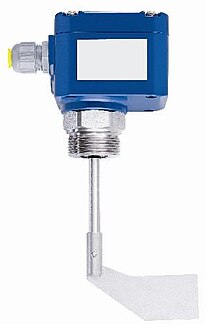Rotary paddle alarm
A rotary paddle switch (also known as a paddle switch) is a level measuring device for level detection in silos and containers for bulk goods . The rotary paddle detectors are used across industries in industrial plant construction.
technical structure
The paddle switch consists of a housing that contains a motor and the electronics. This motor drives a shaft to which a measuring blade is attached. After the device has been installed on the silo, the housing is outside the container wall and the measuring blade and shaft are in the interior of the silo.
functionality
The measuring blade rotates slowly on the shaft in the interior of the silo. As soon as the level of the bulk material covers the measuring blade, its rotation stops. The motor stops running and the stop causes an output signal, e.g. B. in the form of a glowing lamp. If the rotary wing is no longer covered, the motor starts up again. Again, the changed level causes an output signal.
Area of application and possibilities
The rotary paddle alarm is used across industries in international markets in the bulk goods sector. Typical bulk goods are e.g. B. Grain, cement, plastic granulate, ash, etc. The installation takes place either as an empty, full or demand indicator. The respective form of reporting ensures the smooth and consistent use of the stored bulk material.
The challenge lies in the use under difficult mechanical conditions, such as a dusty environment, high temperature and high pressure in the interior of the silo. The dusty environment in connection with the electronics means there is a risk of explosion. However, housing types with different approvals allow use in potentially explosive areas. The approvals vary in international markets, e.g. B. FM for North America, CSA Canadian Standards Association for Canada or Gost for Russia. The rotary paddle detector is installed vertically, horizontally or at an angle in the wall of the silo. The individual installation options are therefore independent of the location and shape of the silo.
literature
- Friedrich Johannaber (Ed.): Plastic and machine operator. 4th edition. Hanser Verlag, Munich 2004, ISBN 3-446-22042-9 .
